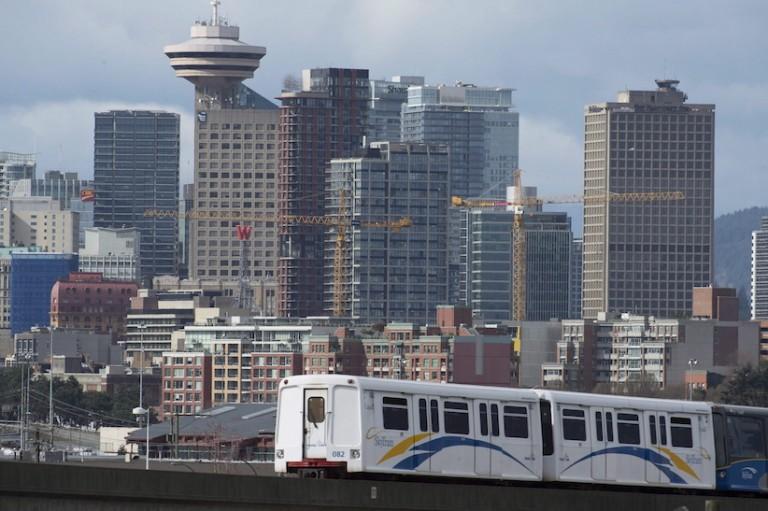Why a big stimulus plan isn’t the fix for what ails Canada
5 things to consider before asking Ottawa to embark on a massive stimulus plan for the Canadian economy

A sky train is pictured in downtown Vancouver, Saturday, March 14, 2015. THE CANADIAN PRESS/Jonathan Hayward
Share

Finding the right policy response to the oil shock is dominating the national economic discussion. Some Bay Street economists like David Rosenberg and Avery Shenfeld have pushed for a serious increase in fiscal stimulus to give a short-term boost to growth. Reports suggest the government is considering several measures, ranging from speeding up the cash disbursements under the already-planned infrastructure program to incentives for energy-saving retrofits of buildings.
However, there are good reasons to remain circumspect about the case for broad and large fiscal stimulus in our current situation. Below are five considerations that ought to be taken into account when assessing any fiscal stimulus package.
1. Canada is a small, open economy
Canada is a fairly small country relative to its trading partners, meaning that exports and imports are a larger proportion of GDP. This matters because fiscal stimulus of any kind will leak across borders, lowering its effectiveness. Estimates of the economic multiplier for small open economies like Canada are lower than for larger countries like the United States.
2. Exchange rate effects
The impact of the oil price drop on the exchange has been very clear, with the loonie falling below US70 cents in recent days. While difficult for those with travel or business expenses in U.S. dollars, the lower exchange rate is a key mechanism of adjustment for the Canadian economy. The new cost advantage for Canadian producers will lead exports to rise and help the economy recover by spurring new economic activity.
However, fiscal stimulus can affect the exchange rate in the other direction. Because fiscal stimulus requires more borrowing, it affects money markets and puts some upward pressure on the exchange rate. This leads to fewer exports and potentially undoes the impact of the stimulus on GDP. The result is the well-known economic argument from the Mundell-Fleming model: Fiscal policy is relatively ineffective when you have flexible exchange rates.
3. Do we have deficient demand?
The impact of the large drop in oil prices has driven a recession not quite like others we have seen. GDP growth has fallen to near zero, but the national unemployment rate really hasn’t changed much. As Stephen Gordon has explained, this is exactly what we should expect from the oil shock—the price of things we export has fallen a lot, which makes us poorer. But there has been less impact on the quantity of goods produced and not much impact on the overall national labour market.
In this kind of circumstance, it is not clear that boosting aggregate demand through fiscal stimulus is the right response.
4. Regional impacts
In 1992, the Atlantic provinces were hit by a large shock to a commodity vital to those economies—the cod moratorium. We didn’t respond to that large regional economic shock by building light rapid transit lines in Saskatoon or sending stimulus bonus cheques to people living in Hamilton. Instead, the focus was on regional strategies targeting the region and industry affected by the shock.
In the current situation with the oil shock, any package aiming to stimulate the economy ought to focus on areas of the country where the economy is currently slack. To motivate a national program, strong evidence of national economic slack is needed.
5. Timing
A perennial concern with active fiscal stimulus is the difficulty of timing. If fiscal stimulus arrives after the recession has abated, it won’t serve the desired purpose.
This concern can be alleviated in two ways. One is by picking a quickly implementable and time-limited measure like renovation tax credits. The other is to focus on infrastructure projects that are “shovel ready,” meaning they can begin quickly.
In our current situation, the federal government may try to speed up its planned infrastructure program. I don’t think there is any harm in rearranging the timing among projects that are sound and productive investments, so I have no objection to an acceleration. But even in the best-case scenario, it’s not clear how quickly infrastructure stimulus can have an effect.
Vancouver provides a clear example of the best-case scenario. The local transit authority, TransLink, has extensive and complete plans for a large transit package, a legacy from last fall’s failed transit referendum. An order for 400 buses is ready to go—but for the funding. These New Flyer buses would be made in Winnipeg, but it’s unlikely they would start rolling off the production line in the next month or two. Similarly, preparations for new transit lines in Surrey and in Vancouver have progressed enough that they could be under construction by the end of the year. It’s hard to imagine infrastructure projects more “shovel-ready” than these, yet the timing of any stimulus from even these best-case scenarios would not be until later in 2016.
Taken together, these five considerations make the case for active and large fiscal stimulus fairly difficult. The Canadians who have been affected by the oil shock deserve the government’s attention, but their economic suffering does not alone make the case for a large national fiscal stimulus initiative. Instead, economic relief more targeted by place and time is likely to produce more effective results.